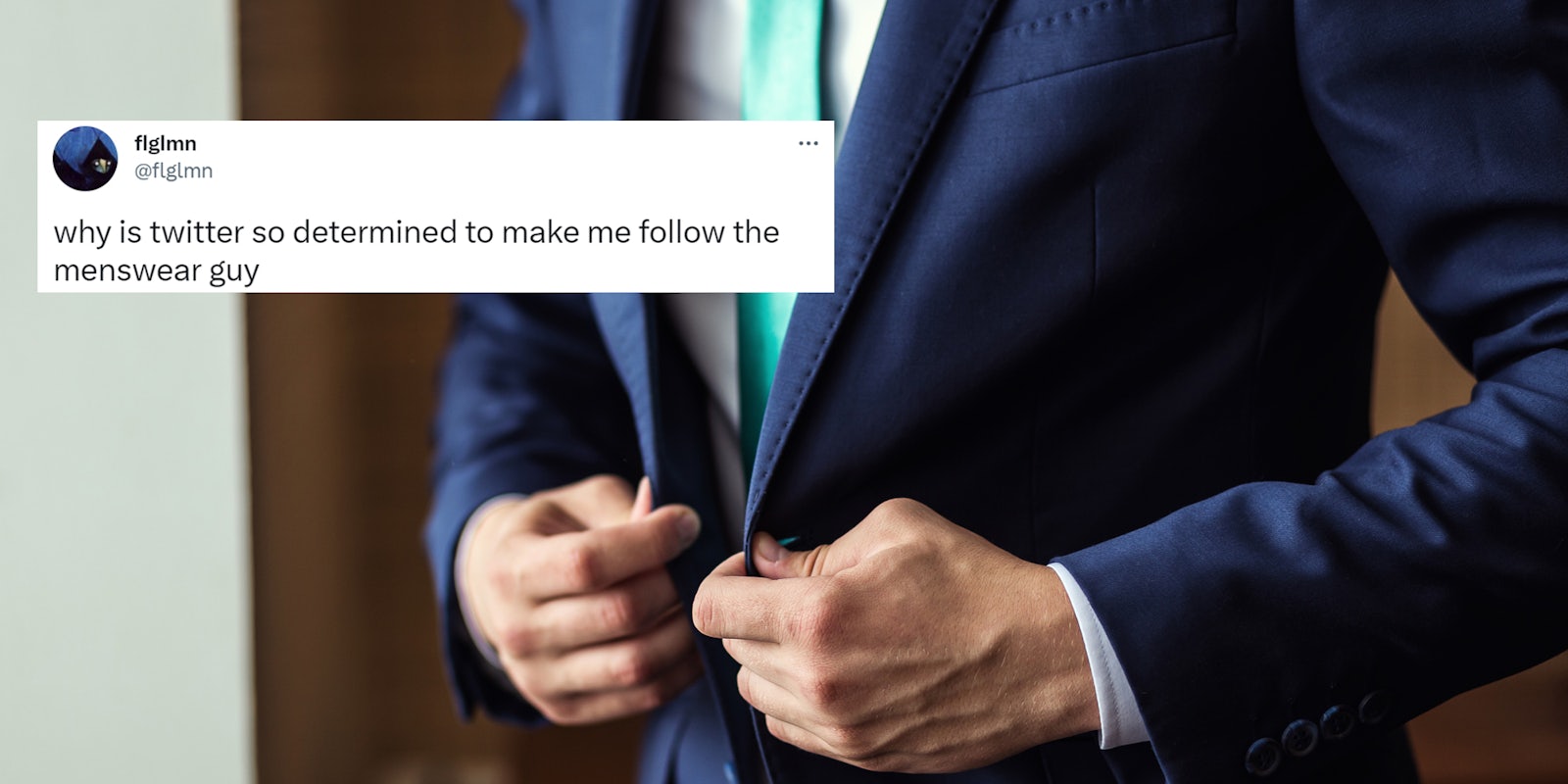No one wants to be Twitter’s main character if they can avoid it. It’s a one-way street to a hellish experience.
Those who do often are there because of their own actions: saying something stupid, for instance, or being outrageously racist.
Not so for Derek Guy, a menswear writer from California who posts as @dieworkwear. His ascension to the central role of millions of users’ Twitter timelines came about totally accidentally—and not at all through his own doing.
After a user asked recently, “why is twitter so determined to make me follow the menswear guy,” a number of people responded to say they too had been inundated with his posts recently.
He is all over everyone’s timelines now and he is just as befuddled.
Guy has been publishing stories and blog posts about menswear on the internet since 2010.
“I got interested in menswear blogs, like a lot of guys in the early 2000s,” he said in an interview with the Daily Dot. “Then I started my own menswear blog,”
Guy is also an editor at Put This On, a self-described “blog about dressing like a grownup.”
In the years since, he had built up a small but dedicated following of like-minded fashion enthusiasts with whom he shared private jokes about the industry. “It’s always been for … I guess you would say it’s a niche audience to a certain degree,” he said.
That all changed in October—around the time Elon Musk purchased Twitter for $44 billion. Then, Guy had around 50,000 followers on Twitter—he now has more than 100,000—and was still posting his usual content of niche in-jokes and wonkish fashion content to his devoted band of followers.
Guy gained a small semblance of notoriety when he called out an overpriced watch being hawked by Dave Portnoy, founder of Barstool Sports. Guy alleged that Portnoy was hawking basic, $40 Quartz watches for thousands of dollars through his Brick Watch Company. Portnoy responded with a video, posted on Twitter, attacking Guy.
“It got me a bit of attention,” Guy said, “but it wasn’t significantly more attention than I’ve had in the past from my quote-unquote ‘semi-viral’ tweets.”
Guy’s ripostes to Portnoy and his fans, who bombarded the menswear commentator with insults, gained him more followers. That came with its own issues.
“After that point, I started to tone down what I used to tweet before,” he said. “I used to mainly tweet jokes because I wrote for a very specific audience; guys who bought brands like Engineered Garments and are into this menswear culture. I started getting self-conscious because a lot of these people started following me, and I just felt like these jokes wouldn’t land.”
He instead pivoted his account to public fashion service, tweeting threads that helped people by leveraging things he’s learned over years.
Those informative threads helped build Guy’s following further and seemed to attract the attention of Elon Musk’s new Twitter algorithm, a TikTok-clone—somewhat like Instagram Reel’s recent ripoff—which is determined to put creators you don’t follow into your feed in any way possible.
But Guy only realized in the last few days that people are being bombarded with his tweets—a change he noticed by reading his mentions.
“I’ve been called a Nazi and all sorts of stuff has been said about me that makes me feel kind of bummed,” he said. “It’s not like I’m going into people’s timelines purposely; that’s just how the algorithm works. It’s created this kind of engagement that sometimes hurts me.”
The impact of being propelled into people’s Twitter feeds has not only had a detrimental effect on those forced to confront Guy’s thoughts on the changing silhouette of men’s suits or leads to follow in tailoring thrift store finds.
It’s also impacted his Twitter experience as users he used to follow have now blocked him.
“Brian Stelter—I think he’s over on CNN— blocked me, which is totally fine,” he said. “I don’t mind at all. It’s reasonable: if you don’t like my content, you should block me, because I’m not trying to make your life unpleasant.”
Stelter did not respond to a request for comment, but did tweet that it was to tamp down Twitter’s algorithmic enthusiasm for surfacing Guy on Stelter’s timeline. “I had to block him to stop him from showing up,” the former CNN journalist wrote. “No offense to him.”
While silent blocks to save users’ sanity have an impact on him, it’s those that go out of their way to let Guy know he’s not welcome that have the most deleterious effect on his own user experience.
“The majority of the responses are positive,” he admits, “but the default mood on Twitter is anger. That does not feel good because I’m not getting paid to tweet this stuff. I do it just because it’s fun. It lowers the fun level and makes me feel kind of crappy.”
Guy is also now way more self-conscious about what he tweets, aware that people who didn’t ask to see his posts may end up encountering them. The larger size of his following has also caused reflection on how he interacts with others. He previously used to mock UNTUCKit, a shirt retailer, and Allbirds, a footwear and clothing company, because they didn’t represent, to him, good menswear.
“Now that a lot of people follow me, I don’t want to make a joke about UNTUCKit or Allbirds, because some people do wear those things, and I don’t want people to feel bad about their clothing choices.”
Despite the challenges, when asked if he’d rather Twitter’s algorithm return back to normal and deamplified him from appearing in so many strangers’ timelines, Guy takes a long, 12-second pause to consider.
“It’s only happened recently,” he said. “I don’t know what benefits will come out of what’s happened the last couple of months. If I can inspire a bunch of people to pick up this hobby, then I find that the most rewarding thing. It’s too early to say.”


